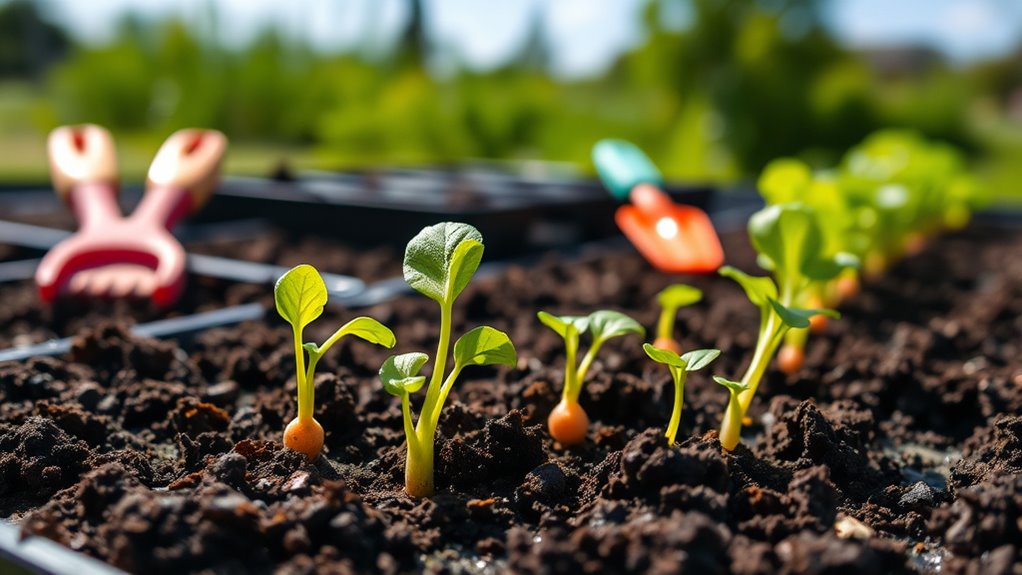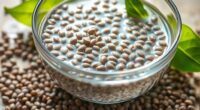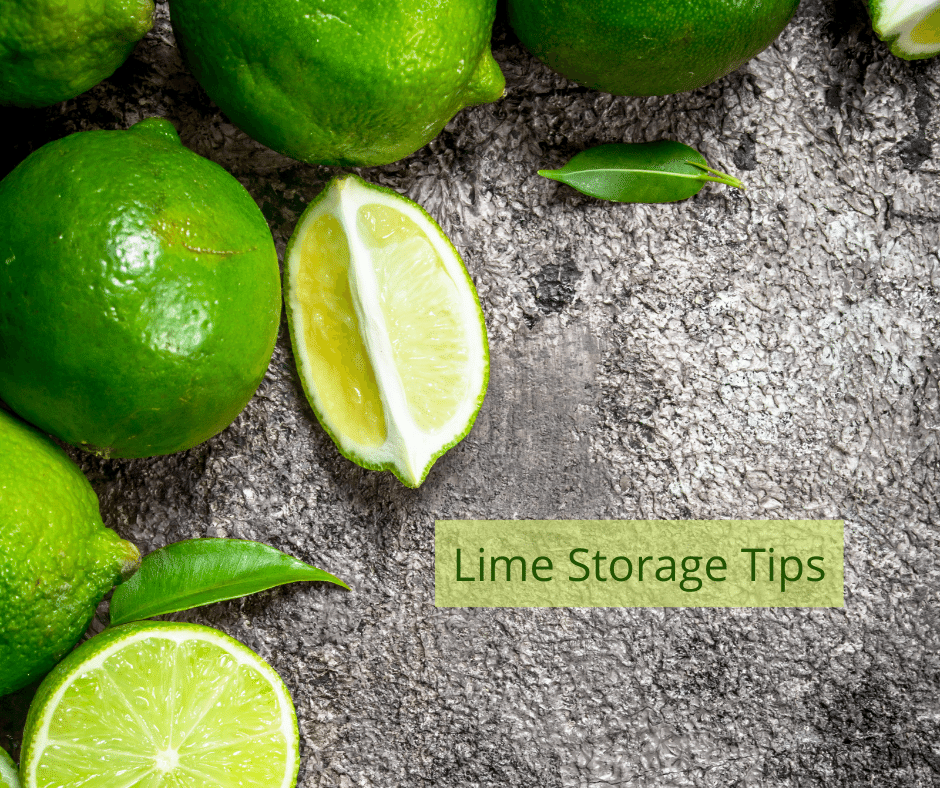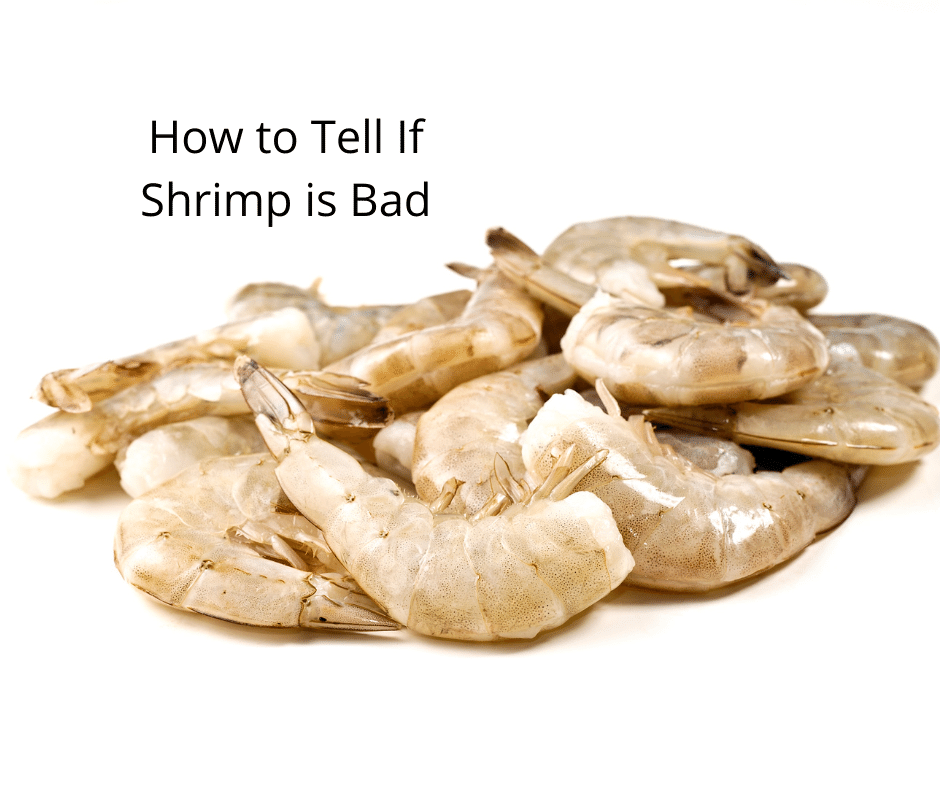If you’re starting your gardening journey, begin with easy seeds like radishes, lettuce, cucumbers, beans, and carrots. These vegetables germinate quickly, require minimal care, and thrive in various conditions, boosting your confidence as a newbie gardener. Growing these simple crops helps you learn patience and gardening basics while ensuring fresh produce with little effort. Keep exploring, and you’ll discover even more secrets to successful gardening as you grow your skills.
Key Takeaways
- Radishes, lettuce, cucumbers, and beans are beginner-friendly vegetables with high germination rates.
- These vegetables require minimal care, making them ideal for first-time gardeners.
- They thrive in diverse conditions, reducing the need for specialized growing environments.
- Growing easy vegetables boosts confidence and encourages ongoing gardening practice.
- Proper soil, watering, and sunlight are essential for successful germination and healthy growth.

Growing vegetables from seed is a rewarding experience, especially for first-time gardeners. Some vegetables are particularly easy to grow and require minimal maintenance, making them ideal choices for beginners. Examples include radishes, lettuce, cucumbers, and beans, which germinate quickly and thrive in various conditions. Additionally, selecting vegetables with high germination rates can improve your success rate and boost confidence in your gardening skills. Proper soil preparation, adequate watering, and sunlight are essential for healthy growth. Starting with these simple crops can help build your gardening skills and lead to a productive and enjoyable gardening experience.
Frequently Asked Questions
What Is the Best Time of Year to Start Seeds Indoors?
You should start seeds indoors about 6-8 weeks before the last expected frost date. This gives your seedlings enough time to develop healthy seedling lighting and strong roots. Keep an eye on transplant timing, so you move them outdoors when conditions are right, usually after the danger of frost has passed. Starting early guarantees your plants are strong and ready to thrive once you transplant them into your garden.
How Do I Prevent Pests From Damaging Young Seedlings?
To prevent pests from damaging your young seedlings, you should implement effective pest control strategies. Start by inspecting your plants regularly and removing any pests manually. Use natural repellents like neem oil or garlic spray to deter insects without harming your plants. Also, encourage beneficial insects such as ladybugs. Keep your garden clean and free of debris, and consider row covers to provide a physical barrier against pests.
What Soil Type Is Ideal for Vegetable Seeds?
You might think all soils work equally, but the ideal soil for vegetable seeds offers excellent drainage to prevent waterlogging and retains enough moisture for healthy roots. It also has high nutrient content to support seedling growth. If your soil is too compacted or poor, amend it with organic matter like compost. This creates a balanced environment, giving your seeds the best start and boosting your gardening success.
How Often Should I Water New Seedlings?
For seedling hydration, you should water new seedlings regularly to keep the soil consistently moist but not waterlogged. Typically, watering frequency depends on your climate and soil, but aim for once a day or every other day. Check the soil moisture by touching the top inch—if it feels dry, it’s time to water. Maintaining proper watering frequency helps seedlings develop strong roots and healthy growth.
Can I Grow These Vegetables in Containers or Only in Garden Beds?
You can definitely grow these vegetables in containers or garden beds. For container gardening, choose pots with proper drainage, and focus on good soil preparation by using quality potting mix. This helps guarantee your seedlings thrive, regardless of the space. Remember to water consistently and provide adequate sunlight. Container gardening offers flexibility, so you can grow your favorite vegetables even if you lack a traditional garden bed.
Conclusion
Now that you know these 10 easy vegetables to start from seed, imagine the satisfaction of watching your garden flourish. Just when you think you’ve mastered the basics, a new challenge or surprise awaits—perhaps a bumper harvest or an unexpected pest. Keep experimenting and stay curious; your gardening journey is only beginning. With each seed you plant, you’re revealing new skills and stories. Are you ready to see what’s next? Your garden’s adventure is just getting started.









